One of the things that always bothered me with our  shuttle program was the fact that Enterprise never saw duty. Well, let me rephrase that: never saw space duty. Fact is, with out Enterprise, the shuttle program would have ground to a halt. See, Enterprise, while a full sized vehicle, was a test orbiter and was never intended to fly in space. It could have been made space worthy, but NASA already had four orbiters in the pipeline with a fifth one that would come later.
shuttle program was the fact that Enterprise never saw duty. Well, let me rephrase that: never saw space duty. Fact is, with out Enterprise, the shuttle program would have ground to a halt. See, Enterprise, while a full sized vehicle, was a test orbiter and was never intended to fly in space. It could have been made space worthy, but NASA already had four orbiters in the pipeline with a fifth one that would come later.
Enterprise, otherwise known as OV-101, got her name from a write in campaign from fans of Star Trek. It was unveiled on September 17, 1976 in Palmdale, California. A few months later, in January of 1977, the orbiter began her career as a test vehicle.
It’s first tests were primarily designed to test the aerodynamics of the craft in the atmosphere. In other words, NASA wanted to verify that the craft could function as a glider, a crucial function of the fleet. The shuttle was supposed to launch like a rocket and land like a plane-an unpowered plane (or glider.) In effect, once it re-entered the atmosphere, the shuttle would become the worlds most sophisticated-and expensive-glider.
Enterprise did, in fact, see a lot of duty. Even as a test vehicle, it was outfitted for launch, tested in both manned and unmanned configurations and, ultimately, served to prove why the shuttle Columbia broke apart upon her final mission. Indeed, the Enterprise’s sacrifice of its wing probably helped to save the few remaining shuttle flights and, as a result, lives of those crews.
The Enterprise could have actually seen duty in space. Originally, the Columbia was going to be the test vehicle and OV-101 would get the space worthy clothing that went to Columbia. Consideration was also given to make the Enterprise a space worthy vehicle in 1986 after the destruction of the Challenger in January of that year. Ultimately, it was decided to build a new vehicle, the Endeavour.
Once the shuttle program was off the ground, so to speak, Enterprise was used for various public relations details, being ferried about like a replica of the Batmobile and was also used for testing mating rigs and launch operations at the Vandenberg Air force Base and in Florida. Vandenberg was ultimately not used for shuttle launches but could have been.
Enterprise also served as a spare parts bin. One notorious episode involved a launch of the Challenger. At t-minus thirty seconds, the launch was aborted because one of the redundant computers (something like a Rockwell Aim-65 microcomputer) failed to communicated with one of the bigger computers. Turns out, a communications bridge (modem) failed. One was taken from Enterprise and the launch proceeded later. Now, I don’t know if this is a true
story, I’ve searched for it and have not been able to verify it, but it does make for an interesting tale nonetheless.
The most recent and perhaps most public use of Enterprise as a spare parts bin was the use of one of its wings to prove that a piece of foam hitting the wing during launch could be catastrophic enough to cause Columbia to break up on re-entry. It was.
Currently, the Enterprise resides in the Dulles Annex of the Smithsonian. Soon, however, it will move to New York City and the
Discovery will take its place in the Smithsonian. While it is a shame that the craft never saw duty in space (imagine how cool it would be to see the real Enterprise launch and have the words ‘starship Enterprise’ spew from some newscaster’s mouth and it be for real…ok, I’m a nerd…) it’s contribution to the program was no less impressive or important as the other craft.

One thought on “Enterprise: the forgotten shuttle”